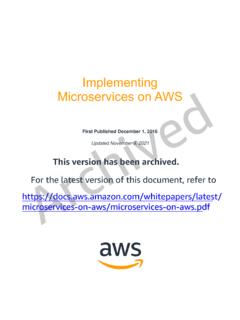Transcription of DevSecOps Fundamentals Playbook - AF
1 UNCLASSIFIED UNCLASSIFIED March 2021 Version DISTRIBUTION STATEMENT A. Approved for public release. Distribution is unlimited. DevSecOps Fundamentals Playbook Unclassified Unclassified UNCLASSIFIED UNCLASSIFIED Trademark Information Names, products, and services referenced within this document may be the trade names, trademarks, or service marks of their respective owners. References to commercial vendors and their products or services are provided strictly as a convenience to our readers, and do not constitute or imply endorsement by the Department of any non-Federal entity, event, product, service, or enterprise UNCLASSIFIED 3 UNCLASSIFIED Contents Play 1: Adopt a DevSecOps Culture .. 4 Key Cultural Practices .. 4 Checklist .. 4 Play 2: Adopt Infrastructure as Code.
2 5 Key Advantages .. 5 Checklist .. 5 Play 3: Adopt Containerized microservices .. 6 Key Characteristics of a Containerized Microservice .. 6 Checklist .. 6 Play 4: Adopt a Capability Model, not a Maturity Model .. 7 Checklist .. 7 Play 5: Drive Continuous Improvement through Key Capabilities .. 8 Checklist .. 8 Play 6: Establish a Software Factory .. 9 Checklist .. 9 Play 7: Define a Meaningful DevSecOps Pipeline .. 10 Checklist .. 10 Play 8: Adapt an Agile Acquisition Policy for Software .. 11 Checklist .. 11 Play 9: Tirelessly Pursue Cyber Resilience .. 12 Checklist .. 12 Play 10: Shift Operational Test and Evaluation (OT&E) Left into the Pipeline .. 13 Common Testing Categories .. 13 Checklist .. 13 UNCLASSIFIED 4 UNCLASSIFIED Play 1: Adopt a DevSecOps Culture DevSecOps is a software engineering culture that guides a team to break down silos and unify software development, deployment, security and operations.
3 Critical to the success of DevSecOps adoption is buy-in from all stakeholders, including: leadership, acquisition, contracting, middle-management, engineering, security, operations, development, and testing teams. Stakeholders across the organization must change their way of thinking from I to we , while breaking team silos, and understanding that the failure to successfully deliver, maintain, and continuously engineer software and its underlying infrastructure is the failure of the entire organization, not one specific team or individual. Before beginning a DevSecOps journey, it is imperative to understand that a successful implementation of DevSecOps cannot be measured by a completely automated pipeline or the interaction between development and operations teams alone; all stakeholders in the organization must be committed to changing the way they view their job responsibilities and, most importantly, interact with each other.
4 Key Cultural Practices Stakeholder transparency and visibility. Complete transparency across team members in real-time. All project resources easily accessible to the entire team; not everyone needs commit privileges. Adopt and embrace ChatOps as the communication backbone for the DevSecOps team. All technical staff should be concerned with, and have a say in, baked-in security. Checklist Learn what is involved in the DevSecOps culture. Embrace automation for anything done repeatedly. Read How to Build a Strong DevSecOps Culture by K. Casey, available online at: Read The Phoenix Project: A Novel about IT, DevOps, and Helping Your Business Win by G. Kim, K. Behr, and G. Spafford, IT Revolution Press, Jan. 10, 2013 Fail fast, learn fast, fail small, and do not fail twice for the same reason!
5 UNCLASSIFIED 5 UNCLASSIFIED Play 2: Adopt Infrastructure as Code Infrastructure as Code (IaC) is infrastructure definition and configuration that is defined with text files that are checked-in to a source code repository and kept under configuration management. It includes the management of networks, storage, virtual machines, load balancers, and even connection topologies. IaC evolved to solve a real-world problem referred to as environment drift in the release pipeline. Succinctly, the development environment fails to align with the production environment configuration. The goal is to automate all infrastructure provisioning and configuration in a repeatable, consistent way that also lends itself to peer reviews of the changes prior to any configuration changes actually being made.
6 IaC can take many forms. One is a template for instantiating a cloud service in a secure way. Another is through configuration files or scripts. It is important to consider vendor lock-in versus product lock-in when selecting technology or IaC formats. Blueprints and Cloud Formation only apply to Microsoft Azure and Amazon Web Services (AWS) respectively, creating a degree of vendor lock-in; Cloud-agnostic solutions, such as those provided by popular tools like Ansible and Terraform, avoid vendor lock-in but create product lock-in. In all cases, the IaC is specified via one or more text files. GitOps is a paradigm where systems are described and observed declaratively, using code to specify the desired state. The benefits of GitOps build upon IaC, emphasizing the role of git and a git driven workflow.
7 IaC is one of the three core practices of GitOps, along with merge requests and the reliance upon a CI/CD pipeline. Key Advantages IT infrastructure supports and enables change, rather than being an obstacle or a constraint. Mitigates drift between environments by leveraging automation and push-button deployment. Enforces change management through GitOps with multiple approvers, as needed. Environmental changes are routine and fully automated, pivoting staff to focus on other tasks. Quicker recovery from failures, rather than assuming failure can be completely prevented. Empowers a continuous improvement ecosystem rather than big bang one and done activities. Checklist Learn how to describe the value proposition of IaC. Understand the benefits of applying GitOps to infrastructure configurations.
8 Understand how IaC tooling selection is a trade-off between vendor lock-in or product lock-in. Explore popular IaC tooling options, including: Terraform Ansible Chef CSP managed service tooling UNCLASSIFIED 6 UNCLASSIFIED Play 3: Adopt Containerized microservices A modular open system approach (MOSA) is an acquisition and design strategy consisting of a technical architecture that adopts open standards and supports a modular, loosely coupled and highly cohesive system Code Title 10 Section 2446a, and DoD Instruction require MOSA. A modern software architecture predicated upon microservices and software containers meet MOSA requirements. A container is a lightweight, standalone, executable package of software that includes everything needed to run a business service except the OS; code, runtime, system tools, system libraries and settings.
9 Containers run in isolated processes from one another, so several containers can run in the same host OS without conflicting with one another. All containers must be Open Container Initiative The DoD DevSecOps Strategy requires a CNCF Certified Kubernetes cluster for container orchestration; there over 90 Certified Kubernetes implementations and A microservice architecture is an approach to application development where discrete, modular business services are bundled inside of a software container. These business services are then loosely coupled and rapidly composed using lightweight protocols. The primary functional benefit of this approach when executed properly is that each service can advance independently from the other services. Numerous non-functional benefits also exist, including more agility in scaling to demand, multiple upgrade options that don t impact the user population, more precise cyber hardening at a per-service level, and inherent support for failure and recovery.
10 Key Characteristics of a Containerized Microservice Componentization via services. Organized around business capabilities. Product over project. Smart endpoints, dumb pipes. Decentralized governance and data management. Infrastructure automation support via IaC. Design for failure. Evolutionary design support. Checklist Research and understand the benefits of a microservices architecture. Only adopt CNCF Certified Kubernetes to ensure software conformance of required APIs. Leverage Iron Bank for hardened containers and other software artifacts. Always inject the Sidecar Container Security Stack (SCSS) to maximize runtime security. Always adopt a service mesh to further secure east-west network traffic. 1 Defense Acquisition University, MOSA Defense Acquisition Guidebook, Ch [Online].









